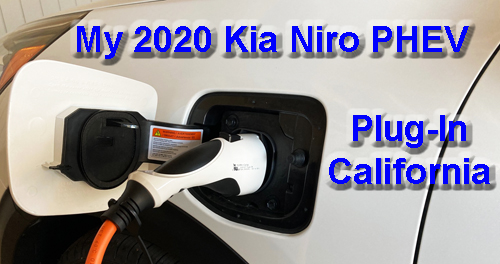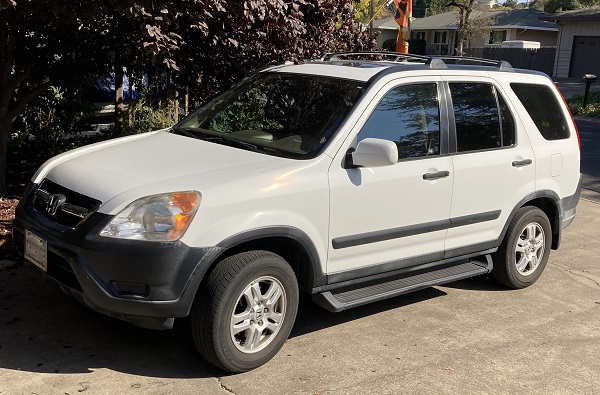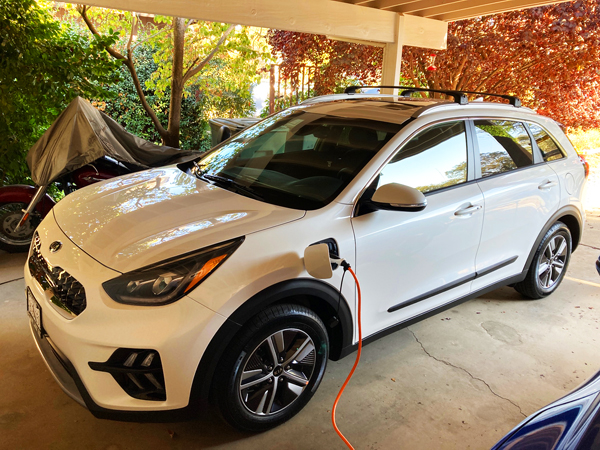After 18 years and 289,000 miles, my 2002 Honda CRV had come to the end of its useful life. It was not dead, but I no longer felt comfortable making any long distant trips for fear of automobile failure. Fortunately, with the Covid shut down, any real travel was significantly curtailed, extending the life of my little car. However, with it burning about a quart of oil every 1,000 miles, a broken speedometer and fuel gauge, I was driving on borrowed time. I now had to undertake the painful process of determining what my next vehicle would be.

Replacing The Honda CRV
Aside from cost considerations, climate change and an individual’s contribution to it through burning fossil fuels, weighs heavily on my mind. At a minimum, a new car had to get great gas milage, which is not hard to do when the CRV only managed 23 MPG around town. There were many hybrid cars on the market that fit my criterion for modest cargo capacity. My CRV had hauled countless pieces of eight-foot lumber, ten-foot PVC pipe, and hundreds of pounds of brick and stone for landscaping projects.
While a car to me means freedom to travel, I also value a utilitarian aspect of lugging furniture, hauling junk to the dump, and occasionally transporting large antique clocks I might acquire. A review of my past vehicle use, coupled with future expectations, repeatedly pointed me toward a compact SUV type of vehicle.

The constant quest for information meant I kept researching how to maximize the utility of a new car while minimizing fossil fuel use. A hybrid vehicle – an electric motor working in tandem or independently of the petrol motor – was a good alternative. Hybrids have good gas milage and the manufacturers were expanding hybrid models even in the SUV class. I was also seeing more all electric SUV vehicles coming into the market. Unfortunately, in late 2020 most of these vehicles were not available and many exceeded my budget.
The middle alternative was a plug-in hybrid. The small all electric range of a plug-in hybrid, 20 to 40 miles, meant I could spend most of my driving time around town without burning any, or very little, petrol. For longer distances the hybrid nature of the plug-ins give good gas milage, many cars are at 40 MPG. There were several small compact SUV plug-in hybrids that fit my budget and design. Two on top of my list, the RAV 4 Prime and Ford Escape, were not available for various reasons.
I must admit I had a somewhat irrational obsession with having an all-wheel-drive SUV, like my CRV. The RAV 4 Prime has AWD. Of course, I’m 57 years old, not 27, and the prospects of needing AWD living in the Central Valley of California are pretty remote. I can count on one hand the number of times the AWD of my CRV was useful. After I came to terms that I am an old man who will not be retracing the Rubicon Trail in a 4 x 4 anytime soon, I was left with two choices, the Toyota Prius Prime or the Kia Niro plug-in hybrid.
Kia Niro PHEV Wins The Research
It does sound crazy that I put the Prius Prime in the same category as the subcompact SUV Niro. From a pure driving perspective, the Prius is a joy to drive. Toyota has refined the Prius to give a very pleasurable driving experience, modest cargo capacity, great gas milage, all at a reasonable price. My issue with the Prius was not the car, its what I want to do with the car. The thought of hauling wood and bricks, installing roof rails or trailer hitch for a bike rack, just did not sit well with me. The Prius is a commuter and long-haul vehicle, not a work truck, although some people have lovingly adapted the Prius for all sorts of activities.

After months of research, hundreds of hours of YouTube video reviews of electric vehicles (EV) and plug-in hybrids (PHEV), I finally selected the Kia Niro EX Premium PHEV. I bought the car on October 30, 2020. The MSRP was $38,325 that included an up charge for the Snow White Pearl paint, cross bars, and carpeted floor mats.
The EX version of the Niro PHEV is about $4,000 less and a good value. Most of the extra features of the EX Premium version I don’t really care about like the larger infotainment screen and sun roof. I was more interested in the LED head lamps and all faux leather seats. For me, if I am not comfortable driving a car, even if it is a BMW, it is not worth it. After driving cars with LED head lights at night, I wanted the extra clarity to the road that the head lamps brought when illuminating the roadway.
Another throwaway feature for me was the ventilated seats. Wow, was I wrong. The cooling feature the ventilated seats bring to the driving experience is amazing. If you live in a hot climate, the ventilated seats are worth the extra cost. The EX Premium also has an upgraded sound system, but I have not been able to review it thus far.
My purchasing experience was pretty good. I contacted the dealership through an email. They offered a 2 percent discount from the MSRP. After looking at my old 2002 CRV, they gave me $500 for the trade-in. The only real negative experience was the overtly sexist finance manager. I was stunned that a man could so easily converse in sentiments and stereotypes of the 1950s when referencing women. From that man’s perspective, most women are prone to swing open their car doors and hit the vehicle next to them. That’s why I needed to add the paint repair warranty he was trying to sell.
Niro Likes and Dislikes
You never really know how you will like a new vehicle, even after a few test drives, until you get it home for everyday driving. So far, I am very pleased with the Kia Niro PHEV. In all EV mode it is very quiet. There is a reverse back up beep-beep like a delivery truck that may annoy some people or their neighbors. I have no problem with the extra safety feature. If I find a way to turn down the volume of the reverse alert beep, I’ll let you know.
The ride is very comfortable. The transition from EV to petrol motor is relatively smooth. The Niro has a dual clutch automatic transmission compared to the new continuously variably transmissions (CVT) of many other PHEVs. People complain that the CVTs can allow the engine to whine at high RPMs whereas the standard automatic transmission will shift gears.
The regenerative braking paddles on the back of the steering wheel are great. On level 3 it is almost like one-peddle driving. It is very aggressive regenerative braking that recharges the battery. Visibility is good, not great. The blind spot monitoring is a feature I really like because I can’t always turn my head, due to neck pain. It adds another element of safety.
Plug-In Hybrid PHEV
With the Niro PHEV I’ll have 26 miles of all EV range and approximately 44 miles per gallon when burning gasoline in hybrid mode. Except in the winter when the petrol engine must run to heat up the cabin, I should be traveling in all EV mode when I trek out to the grocery story, Post Office, or even to see one of my local clients. My goal with a new car is to reduce my fossil fuel consumption as much as possible. The Niro PHEV will meet that goal, short of investing in an all EV car.
Overall, I’m very happy with the new Kia Niro PHEV. I’m sure there will be something that will irritate me in the future. I am adaptable now that I am in my late 50s. The Niro doesn’t easily hold all of my containers of recyclable aluminum cans like the CRV. I’ll deal with it. If it is snowing, I won’t go skiing or snow-shoeing, since it is not AWD. I’ll wait for clear weather.
On October 31, 2020, weather in Northern California was clear and warm. It is unseasonably warm, due to climate change. With all the fires that exploded in California this past summer, a direct result of climate change, it would be irresponsible of me not to try and reduce my carbon foot print as much as possible. The Niro PHEV sets me on the path to do that. The Kia Niro PHEV, hybrid and EV are worth a close look for saving fuel and a comfortable ride.
I did not include a bunch of photos because the Kia website does a good job with images. Below is a YouTube video where I review the outside, interior, and ride quality in all EV mode. I’ll add more videos of the Niro as I track it’s performance and whether it is meeting my desired goals.


